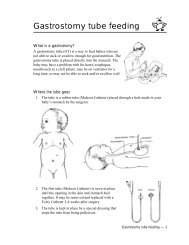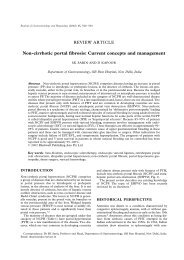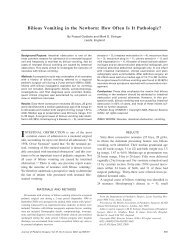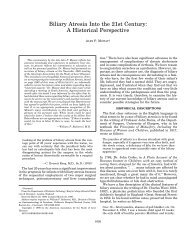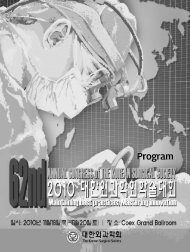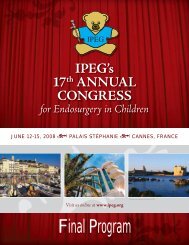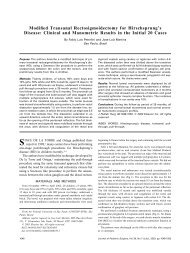Langerhans' cell histiocytosis as a cause of periportal abnormal ...
Langerhans' cell histiocytosis as a cause of periportal abnormal ...
Langerhans' cell histiocytosis as a cause of periportal abnormal ...
Create successful ePaper yourself
Turn your PDF publications into a flip-book with our unique Google optimized e-Paper software.
374 M. Kim et al.: MRI <strong>of</strong> hepatic Langerhans’ <strong>cell</strong> <strong>histiocytosis</strong>Table 1. Clinical data and outcome in three childrenC<strong>as</strong>e Age (mo) Sex Presenting symptoms Organs involved Outcome, treatment1 11 M Poor oral intake Skin, lymphnodes, liver2 24 M Abdominal distension,Scalp, livervomiting, and diarrhea3 18 M Limping gait Ilium, spine,liverHepatic dysfunction, aliver transplantationHepatic dysfunction, aliver transplantationStable, chemotherapya Hepatic dysfunction developed 1 1 ⁄2 years after an initial presentationTable 2. Summary <strong>of</strong> MR imaging and pathologic findings <strong>of</strong> the liverin three childrenC<strong>as</strong>e MR imaging Pathology1 Smooth hepatic surface,diffuse PASI2 Nodular hepatic surface,diffuse PASI, unevenlydilated intrahepatic bileducts3 Smooth hepatic surface,mild PASI in centralportal tractshowed hepatosplenomegaly and thickly crusted patches on the scalp.Laboratory examination showed an elevated serum level <strong>of</strong> alkalinephosphat<strong>as</strong>e (1075 IU/L), <strong>as</strong>partate aminotransfer<strong>as</strong>e (134 IU/L), andalanine aminotransfer<strong>as</strong>e (121 IU/L).US showed heterogeneous hepatic parenchymal echoes and <strong>periportal</strong>hypoechogenicity. MR images <strong>of</strong> the liver showed thick, <strong>abnormal</strong>PASI, intrahepatic bile duct dilatation, and nodular appearance <strong>of</strong> theenlarged liver (Fig. 2A,B). On contr<strong>as</strong>t-enhanced T1-WIs, relativelyhypointense nodular lesions were found adjacent to an <strong>abnormal</strong> <strong>periportal</strong>enhancement (Fig. 2C).In addition to the findings typical <strong>of</strong> LCH from biopsy <strong>of</strong> thescalp and liver, secondary changes <strong>of</strong> extrahepatic bile duct obstructionand cholangitis were seen. Although chemotherapy had beencontinued for 1.5 years, he developed hematemesis and melena. Hereceived a liver transplantation from a cadaveric donor. Gross andmicroscopic examination <strong>of</strong> the explanted liver showed nodularhepatic surface, severe secondary sclerosing cholangitis, and bileduct proliferations.C<strong>as</strong>e 3Biliary cirrhosis, extensive<strong>periportal</strong> fibrosisBiliary cirrhosis, extensive<strong>periportal</strong> fibrosis, secondarysclerosing cholangitisBile ductular proliferation,periductal histiocytes, andinflammatory <strong>cell</strong>sPASI; <strong>periportal</strong> <strong>abnormal</strong> signal intensity on T1, T2, and contr<strong>as</strong>tenhancedT1 weighted imagesA 18-month-old boy presented with a limping gait. Physical examinationshowed hepatomegaly. Laboratory examination showed an elevatedserum level <strong>of</strong> alkaline phosphat<strong>as</strong>e (626 IU/L), <strong>as</strong>partate aminotransfer<strong>as</strong>e(53 IU/L), and alanine aminotransfer<strong>as</strong>e (186 IU/L). An osteolyticlesion <strong>of</strong> the right iliac bone and flattening <strong>of</strong> the 8th and 9th thoracicvertebrae were found on plain radiographic examination.US <strong>of</strong> the liver showed slightly incre<strong>as</strong>ed parenchymal echoes andsmall round hypoechoic nodules in the left lobe. MR images <strong>of</strong> the livershowed PASI confined to the central portal tract (Fig. 3A,B).The diagnosis <strong>of</strong> LCH w<strong>as</strong> made from biopsy <strong>of</strong> the right ilium andthe liver. Liver biopsy showed bile ductular proliferation, periductalhistiocytic, and lymphocytic infiltration. Chemotherapy w<strong>as</strong> initiatedwith prednisolone and vinbl<strong>as</strong>tine and w<strong>as</strong> then continued with cyclophosphamideand VP-16. On follow-up MR images obtained 2 yearslater, PASI showed near complete resolution (Fig. 3C). The patient h<strong>as</strong>not developed any clinical manifestations <strong>of</strong> hepatic dysfunction for 3years after diagnosis.DiscussionIn children with LCH, hepatic involvement is common.At presentation, hepatomegaly is observed in up to 60%<strong>of</strong> patients with disseminated LCH [3], but hepatomegalydoes not always portend a poor prognosis. Hepatic dysfunctionssuch <strong>as</strong> jaundice, hypoproteinemia, and portalhypertension may be present at the time <strong>of</strong> diagnosis ormay develop over months or years [1–3]. In all threepatients, clinical manifestation <strong>of</strong> hepatic dysfunction w<strong>as</strong>not evident at the time <strong>of</strong> diagnosis.Morphologic changes <strong>of</strong> the liver in LCH have beendescribed in a number <strong>of</strong> previous studies. A reportfrom the Children’s Cancer Study Group h<strong>as</strong> describedfour patterns: (a) portal triaditis with infiltrating neutrophils,eosinophils, or mononuclear <strong>cell</strong>s; (b) bileduct proliferation with triaditis; (c) fibrohistiocyticchange; and (d) nodular parenchymal lesion with triaditis[1]. Other reports have described triaditis, <strong>periportal</strong>fibrosis, or liver cirrhosis and bile st<strong>as</strong>is and bileduct proliferation in some c<strong>as</strong>es [2, 3, 9–11]. We couldnot confirm the sequential change <strong>of</strong> hepatic pathologyin each patient, but bile ductal proliferation and periductalinflammatory <strong>cell</strong> infiltration were noted in thepretreatment liver biopsy <strong>of</strong> patient 3. Biliary cirrhosisand extensive periductal fibrosis w<strong>as</strong> seen in the explantedliver <strong>of</strong> patients 1 and 2, who had developedhepatic dysfunction. In patient 2, secondary sclerosingcholangitis w<strong>as</strong> also noted.US finding <strong>of</strong> the liver in LCH h<strong>as</strong> been described<strong>as</strong> hypoechoic nodule or <strong>periportal</strong> hyperechogenicitythat may be attributed to inflammatory <strong>cell</strong> infiltrationor fat content [4, 5, 7, 8]. US in the present c<strong>as</strong>esshowed <strong>periportal</strong> hypoechogenicity that w<strong>as</strong> band-like




